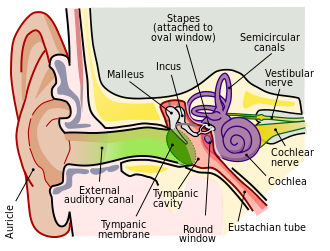Tone decay test


Tone Decay Test is a specialized audiometry test used in the field of audiology to assess the ability of the auditory system to sustain hearing sensitivity over time. This test is particularly useful in identifying abnormalities related to the auditory nerve and central auditory pathways, which may not be detected through standard pure-tone audiometry tests.
Overview[edit]
The Tone Decay Test measures the ability of an individual to maintain perception of a continuous pure tone at the threshold level over a specified period. The test is typically conducted using audiometer headphones, where a tone is presented to the ear at the threshold level of hearing for that frequency. The duration for which the individual can perceive the tone before it "decays" or becomes inaudible provides insight into the integrity of the auditory system, particularly the auditory nerve and higher auditory pathways.
Procedure[edit]
The procedure for the Tone Decay Test involves presenting a continuous pure tone at the threshold level to the test ear. The tone is usually presented for a period of 60 seconds, and the patient is instructed to indicate when the tone is no longer audible. If the tone becomes inaudible, the intensity is increased by 5 dB and presented again until the patient can hear the tone for the full duration. The amount of increase in intensity required to maintain audibility of the tone for 60 seconds is recorded as the tone decay.
Clinical Significance[edit]
The Tone Decay Test is significant in diagnosing and differentiating between sensorineural hearing loss related to cochlear pathology and that originating from the auditory nerve or central auditory pathways. A positive tone decay, where significant increase in intensity is needed to maintain audibility, suggests retrocochlear pathology such as acoustic neuroma or other neural abnormalities. In contrast, minimal to no tone decay is typically observed in normal hearing individuals or those with cochlear hearing loss.
Limitations[edit]
While the Tone Decay Test provides valuable information about the auditory system's function beyond the cochlea, it has limitations. The test is subjective, relying on patient response, which can be influenced by attention, understanding, and cooperation. Additionally, the test does not specify the exact location of the pathology within the auditory nerve or central auditory pathways.
Conclusion[edit]
The Tone Decay Test is a useful tool in the audiological assessment, particularly for identifying auditory system abnormalities beyond the cochlea. It complements other audiometric tests to provide a comprehensive evaluation of hearing function and pathology.
Ad. Transform your life with W8MD's Budget GLP-1 injections from $75


W8MD offers a medical weight loss program to lose weight in Philadelphia. Our physician-supervised medical weight loss provides:
- Weight loss injections in NYC (generic and brand names):
- Zepbound / Mounjaro, Wegovy / Ozempic, Saxenda
- Most insurances accepted or discounted self-pay rates. We will obtain insurance prior authorizations if needed.
- Generic GLP1 weight loss injections from $75 for the starting dose.
- Also offer prescription weight loss medications including Phentermine, Qsymia, Diethylpropion, Contrave etc.
NYC weight loss doctor appointmentsNYC weight loss doctor appointments
Start your NYC weight loss journey today at our NYC medical weight loss and Philadelphia medical weight loss clinics.
- Call 718-946-5500 to lose weight in NYC or for medical weight loss in Philadelphia 215-676-2334.
- Tags:NYC medical weight loss, Philadelphia lose weight Zepbound NYC, Budget GLP1 weight loss injections, Wegovy Philadelphia, Wegovy NYC, Philadelphia medical weight loss, Brookly weight loss and Wegovy NYC
|
WikiMD's Wellness Encyclopedia |
| Let Food Be Thy Medicine Medicine Thy Food - Hippocrates |
Medical Disclaimer: WikiMD is not a substitute for professional medical advice. The information on WikiMD is provided as an information resource only, may be incorrect, outdated or misleading, and is not to be used or relied on for any diagnostic or treatment purposes. Please consult your health care provider before making any healthcare decisions or for guidance about a specific medical condition. WikiMD expressly disclaims responsibility, and shall have no liability, for any damages, loss, injury, or liability whatsoever suffered as a result of your reliance on the information contained in this site. By visiting this site you agree to the foregoing terms and conditions, which may from time to time be changed or supplemented by WikiMD. If you do not agree to the foregoing terms and conditions, you should not enter or use this site. See full disclaimer.
Credits:Most images are courtesy of Wikimedia commons, and templates, categories Wikipedia, licensed under CC BY SA or similar.
Translate this page: - East Asian
中文,
日本,
한국어,
South Asian
हिन्दी,
தமிழ்,
తెలుగు,
Urdu,
ಕನ್ನಡ,
Southeast Asian
Indonesian,
Vietnamese,
Thai,
မြန်မာဘာသာ,
বাংলা
European
español,
Deutsch,
français,
Greek,
português do Brasil,
polski,
română,
русский,
Nederlands,
norsk,
svenska,
suomi,
Italian
Middle Eastern & African
عربى,
Turkish,
Persian,
Hebrew,
Afrikaans,
isiZulu,
Kiswahili,
Other
Bulgarian,
Hungarian,
Czech,
Swedish,
മലയാളം,
मराठी,
ਪੰਜਾਬੀ,
ગુજરાતી,
Portuguese,
Ukrainian
